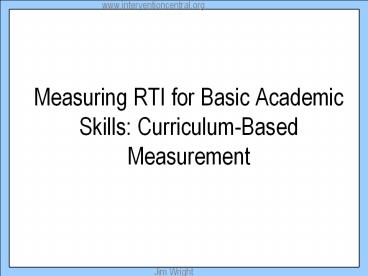Measuring RTI for Basic Academic Skills: Curriculum-Based Measurement - PowerPoint PPT Presentation
1 / 52
Title:
Measuring RTI for Basic Academic Skills: Curriculum-Based Measurement
Description:
Title: PowerPoint Presentation Author: Mimi Mark Last modified by: Jim Wright Created Date: 5/19/2002 11:37:29 PM Document presentation format: On-screen Show – PowerPoint PPT presentation
Number of Views:115
Avg rating:3.0/5.0
Title: Measuring RTI for Basic Academic Skills: Curriculum-Based Measurement
1
Measuring RTI for Basic Academic Skills
Curriculum-Based Measurement
2
(No Transcript)
3
http//www.interventioncentral.org/htmdocs/interv
entions/cbmwarehouse.shtml
4
(No Transcript)
5
Curriculum-Based Measurement An Introduction
-----Jim Wrightwww.interventioncentral.org
6
Using Data for Intervention (RTI) Team Referrals
Teacher Referral
Initial Meeting Held
Follow-Up Meeting Held
Intervention Started Monitored
7
Formative Assessment to Monitor Response to
Intervention
- Definition Ongoing assessment of progress
toward a long-term or major objective. - Example Curriculum-Based Measurement in Reading
Fluency or Math Computation
8
Formative Assessment Advantages
- Provides teacher with pulse measures ongoing
information about student progress - Permits teacher to see direct impact of teaching
strategies on student performance - Allows teacher to create local norms against
which to compare the academic performance of a
target student - Prevents instructor from spending too much time,
effort on strategies that are ineffective
9
(No Transcript)
10
Curriculum-Based Measurement Defining
Characteristics
- Tests preselected objectives from local
curriculum - Has standardized directions for administration
- Is timed, yielding fluency, accuracy scores
- Uses objective, standardized, quick guidelines
for scoring - Permits charting and teacher feedback
11
CBM Techniques have been developed to assess
- Reading fluency 1-minute probes
- Math computation 2-minute probes
- Writing 4-minute probes
- Spelling
- Phonemic awareness skills
12
CBM Oral Reading Fluency
13
http//www.nichd.nih.gov/publications/nrppubskey.
cfm
14
NRP Conclusions Regarding Importance of Oral
Reading Fluency
- An extensive review of the literature indicates
that classroom practices that encourage repeated
oral reading with feedback and guidance leads to
meaningful improvements in reading expertise for
studentsfor good readers as well as those who
are experiencing difficulties.-p. 3-3
15
CBM Reading Probes Preparation
16
CBM Reading Assessment Preparation
- Decide on measurement pool (e.g., basal reading
series, literature selections sorted according to
readability) - Prepare examiner and student copies of passages
- Select passages randomly from larger library when
administering to student
17
CBM Reading Measurement Pool Silver Burdett
Ginn (1989)
- Book 1 All Through the Town.Grade 1
Book 2 Out Came the Sun..Grade 1
Book 3 Morning Bells...Grade 1
Book 4 Make A WishGrade 1
Book 5 A New DayGrade 1
Book 6 Garden Gates..Grade 2
Book 7 Going PlacesGrade 2
Book 8 Castles of SandGrade 3
Book 9 On the Horizon.Grade 3
Book 10 Silver Secrets.Grade 4
Book 11 Dream Chasers..Grade 5
Book 12 Wind by the Sea.Grade 6
18
CBM Reading Probes Example
19
CBM Reading Probes Administration
20
CBM Reading Probes Administration
Materials needed
- 3 passages selected at random from probe
collection - Stopwatch
- Pen or marker
- Quiet, non-distracting location
21
CBM Reading Assessment Administration
- Sit at table next to or across from student
- Read off standardized directions
- Start stopwatch after (a) student reads first
word, or (b) examiner provides first word
22
CBM Reading Assessment Administration
- Supply correct word if student hesitates for
longer than 3 seconds - Mark errors on examiner passage
- Mark student stopping point in passage () at
end of 60 seconds - Tell student to stop reading
23
CBM Reading Probes Scoring
24
CBM Reading Assessment Scoring
- Words are counted as correct if . . .
- the student repeats a correctly read word
- the student self-corrects within 3 seconds
- variant pronunciation of a word is due to
dialectical differences or speech articulation
issues
25
CBM Reading Assessment Scoring
- Words are counted as incorrect if they are. . .
- mispronunciations
- substitutions (e.g., home for house)
- omissions
- hesitations of greater than 3 seconds
- word transpositions
26
CBM Reading Assessment Scoring
- Words read aloud are ignored if. . .
- the student inserts them into the text
27
CBM Reading Assessment Computing Correctly Read
Words
- Number of correctly read words (CRW) is
calculated by
- subtracting number of errors (E) from
- total read words (TRW) during timed minute
--words read up to end bracket in passage
28
CBM Reading Assessment Computing Correctly Read
Words
- TRW74
- Errors5
- CRW69
29
Student Record Form CBM Oral Reading
FluencyPage 1
30
Student Record Form CBM Oral Reading
FluencyPage 2
31
Student Information Block
32
Step 1 Survey-Level Assessment
33
Table 1 Reading Placement Guidelines
34
Step 2 Compute a Student Reading Goal
35
Step 3 CollectBaseline Data
36
Step 4 Progress-Monitoring
37
Table 2 Predictions for Reading Growthby Grade
38
(No Transcript)
39
CBM Reading Probe 1
40
CBM Reading Assessment Recording Scores
Lvl 4-1 Probe 1,2,3
9/23
4
49
45
92
41
CBM Reading Assessment Selecting Median Values
42
Creating CBM Monitoring Charts
43
Creating CBM Monitoring Charts
44
Sample Peer Tutoring Chart
45
Sample Peer Tutoring Chart
46
Jared Chart Baseline Data Select Baseline
Rdng Rate
47
Jared Plot the CBM Aim-Line
X
X
Aim-Line
48
Jared Intervention Phase 1 Weeks 1-6
X
X
F 3/7 82 CRW
Th 2/27 79 CRW
W 1/29 77 CRW
Th 2/13 75 CRW
M 2/3 75 CRW
W 1/22 71 CRW
49
CBM Group (Local) Norms
50
Research Norms for CBM Reading
51
Example CBM Grade-Wide Norms Grade 4 Correctly
Read Words
- 31 34 34 39 41 43 52 55 59 61 68 71 74 75 85 89
102 108 112 115 118 118 131
52
Select boxplot values from this 4th Grade data
series
- 34 39 41 52 55 61 68 71 75 89 108
53
Displaying Group NormsBoxplot
Baylor Elementary School Grade-Wide Norms 23
Students































